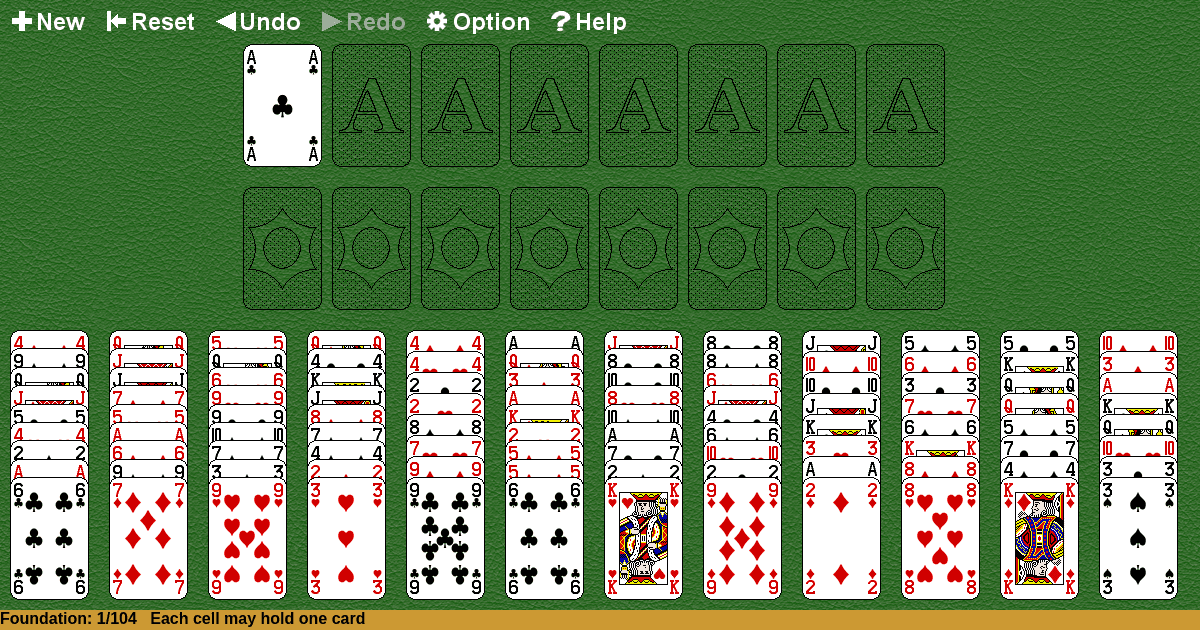FreeCell Duplex
Home |
How to play |
FAQ |
About
How to play FreeCell Duplex?
Game Objective:
The primary goal in FreeCell Duplex Solitaire is to move all cards from the tableau and cells to the foundation piles, building each foundation in ascending order by suit from Ace to King.
Setup & Layout:
- Deck: Uses a standard 52-card deck.
- Tableau: Deal all 52 cards face-up into eight tableau columns. Each column receives either six or seven cards, ensuring all cards are visible from the start.
- Foundations: Four empty foundation piles are placed, one for each suit. These will be built up from Ace to King.
- Cells: There are eight FreeCells (distinct from classic FreeCell, which uses four). Each cell can hold a single card at a time.
- Face Orientation: All cards are dealt face-up in the tableau; there are no face-down cards in play.
Key Play Areas:
- Tableau: The main play area with eight columns of face-up cards.
- Foundations: Four piles, one per suit, to be built from Ace to King.
- Cells: Eight individual spaces, each able to temporarily hold one card.
FreeCell Duplex Solitaire Rules:
- Card Movement:
- Only one card may be moved at a time, either from the tableau or from a cell.
- Cards can be moved from the tableau or a cell to another tableau column, a foundation, or a cell.
- Building on the Tableau:
- Cards are built in descending order, alternating colors (e.g., a black 7 on a red 8).
- Only the top card of each tableau column or a card from a cell may be moved.
- Building Foundations:
- Foundations are built up by suit, starting with the Ace and proceeding in ascending order to the King.
- Cells:
- Each cell can hold only one card.
- Cards in cells can be moved back to the tableau or to the foundations at any time, following the above rules.
- Empty Tableau Columns:
- Any single card (from tableau or cell) may be moved to an empty tableau column.
Gameplay:
- Typical Sequence of Actions:
- Move cards between tableau columns, following the descending and alternating color rule.
- Move cards to the eight cells for temporary storage.
- Build up the foundation piles by suit, starting with Aces.
- Move cards from cells back to the tableau or directly to the foundation as needed.
- Introducing New Cards:
- There is no stock or reserve; all cards are in play from the start.
- No More Legal Moves:
- If no moves are available (no cards can be moved according to the rules and all cells are occupied), gameplay halts and the game is lost.
Winning & Losing Conditions:
- Winning:
- The game is won when all 52 cards are successfully moved to the four foundation piles, in ascending order by suit.
- Losing:
- The game is lost or unwinnable if no legal moves remain and not all cards have been transferred to the foundations.
Special Rules & Edge Cases:
- Filling Empty Spaces:
- Any single card (from the tableau or a cell) may be moved into an empty tableau column.
- Cells:
- Each of the eight cells can hold only one card at a time. Cards may be freely moved between cells, tableau, and foundations, provided all other movement rules are followed.
- Sequence Movement:
- Only single cards may be moved at a time, not sequences or stacks. However, using empty cells and empty tableau columns, players may execute "supermoves" by moving cards one at a time in succession to simulate moving a sequence.
- No Redeal:
- There is no redeal or reshuffling; all cards are visible and in play from the start.
- No Stock or Reserve:
- There are no additional piles from which to draw cards during play; all cards are dealt at the beginning.
Note: FreeCell Duplex Solitaire is distinguished from standard FreeCell by its use of eight FreeCells instead of four, increasing the flexibility and potential for strategic play. All other core rules and objectives remain consistent with classic FreeCell principles.

Solitaire Collection
About FreeCell Duplex
Rate (FreeCell Duplex)
4.7 / 5
1,916 votes



























































